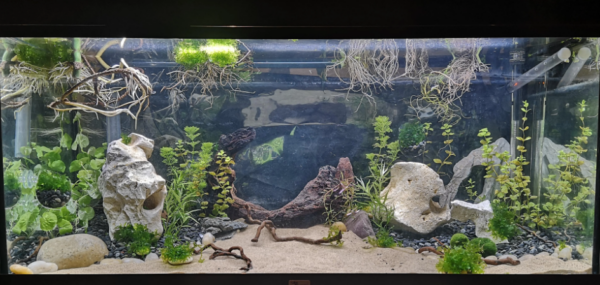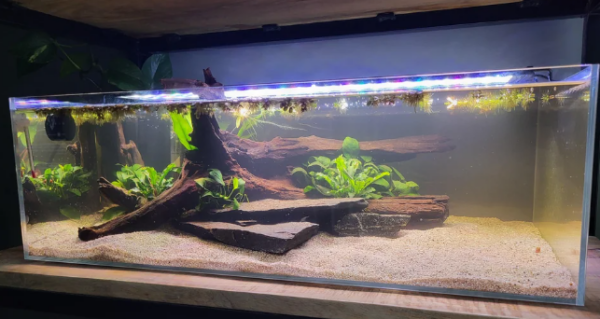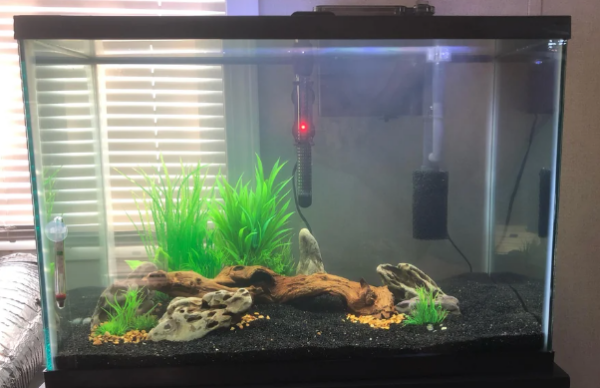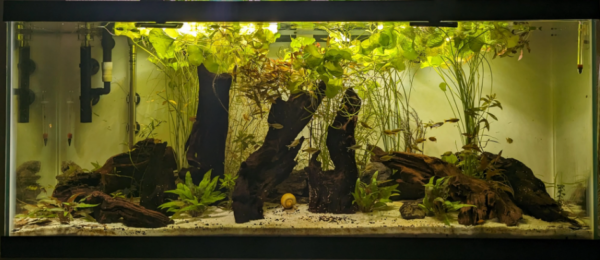Produced by fish waste and the decomposition of protein-based food sources, ammonia is toxic to fish, shrimp, and other aquatic creatures. The existing ammonia is converted to nitrite and nitrate by nitrifying bacteria in aquariums.
While all of these are harmful to varying levels, ammonia and nitrite are particularly detrimental to your aquatic friends’ health. Nitrate is potentially dangerous only in higher concentrations and is essentially removed by water changes.
Cycling and seasoning allow for the colonization of nitrifying bacteria in aquariums and the removal of nitrite and nitrate from the water. Both of the processes exist in a healthy tank with plants and fish.
In this article, we’ll go through the details, benefits, and drawbacks of the cycling and seasoning process and decide the better one.
Table of Contents
What is Cycling Your Aquarium?
Cycling refers to growing beneficial nitrifying bacteria in your aquarium. These bacteria colonies break down the dissolved ammonia in the water—generated through food waste and fish poop—to form nitrite in the initial stages. The nitrite is then turned into less-harmful nitrate as an end product, which is then removed by water changes.
The beneficial bacteria and the nitrogen cycle don’t exist automatically in aquariums. Several techniques and products are employed by aquarists to introduce the bacteria into the tank and help them colonize the substrate, filter media, and decorations.
Here are the two most popular methods:
Fishless Cycling
Fishless cycling is the quickest and most humane way to start cycling your aquarium. It may take between a month and three to completely cycle your tank without introducing any live fish in it.
Liquid ammonia dosing and regular water testing is by far the most efficient method for fishless cycling. Add the appropriate amount of ammonia, depending on your tank size, and test the water at least bi-weekly. Observe any changes in ammonia, nitrite, or literate levels.
A dip in ammonia values and a spike in nitrite indicate a fully cycled tank. Optimally, it should take 24 hours to transform 3-4 ppm ammonia into nitrite.
Another instant fishless cycling method is to introduce established biomedia in your aquarium. You can ask your friend or pet store to provide you with a running filter sponge to help you kickstart the process. The already existing beneficial bacteria will take over the bioload soon after.
Furthermore, having plants can help accelerate the process and minimize water changes.
Fish-In Cycling
In unfortunate situations or when the fish looks too cute to pass on, you may include a live fish in your cycling process. While it should never be your first option, it can be done with a few supplies and patience.
You need bottled bacteria, a filter with lots of surface area, plants, and a water change schedule.
The bottled bacteria, ones from API and Tetra, accelerate the establishment of healthy bacteria in new freshwater setups. The filter with sponge allows the bacteria to colonize and start working on the waste produced by the fish.
You should also focus on minimizing the fish waste in the initial stages. Feed your fish as little as possible for the first week and allow the small amount of bacteria to multiply. Increase their food intake gradually and keep monitoring the ammonia and nitrite parameters. In a few weeks, you may see a nitrite spike before everything stabilizes.
Plants can help absorb the excess nitrite and nitrate from the water to help your fish survive the initial stressful conditions. Regular water changes, similarly, reduce the toxin load.
Benefits of Cycling
Aquarium cycling is a critical process in establishing a healthy and stable aquatic environment. The benefits of cycling your aquarium are:
Establishment of Nitrogen Cycle
Cycling promotes the establishment and growth of beneficial nitrifying bacteria, such as Nitrosomonas and Nitrobacter. These bacteria play a critical role in converting toxic ammonia into nitrite and then nitrate.
Ammonia Reduction
Subsequently, ammonia levels are reduced in the tank to maintain a healthy aquatic environment. Nitrite is also converted into nitrate to help reduce toxicity even further.
Stabilization of Water Parameters
Sudden fluctuation of water parameters can negatively affect the well-being of your fish. In addition to ammonia and nitrite, cycling also improves the stability of water parameters such as pH, nitrate levels, and water hardness.
Prevention of Fish Stress and Disease
A poorly cycled aquarium can introduce stress in your fish. Which often causes parasitic and bacterial outbreaks in the tank—causing disease and death. The absence of ammonia and nitrite can reduce stress quite effectively.
Plant Growth
Nitrate and other end products of the nitrogen cycle serve as nutrients for the aquatic plants present in your tank. Nitrogen absorption happens faster than water changes and is the basis of aquarium seasoning.
Drawbacks of Cycling
The drawbacks of cycling compared to seasoning are:
Not Enough Setup Time
Despite taking months, cycling doesn’t nearly equate to the setup time required to call a tank “seasoned”. A longer setup time with different elements like plants, substrate, and decorations stabilizes the ecosystem.
Potentially Harmful to Fish
Both fishless and fish-in cycling can be potentially harmful to fish if not given enough time to stabilize the process. Fish-in cycling, understandably, subjects the fish to undue stress and diseases. On the other hand, fish may be introduced faster than mandated in fishless cycling.
Fragile Ecosystem
A cycled tank depends on a lot of factors to function properly. As a relatively new setup with minimal to zero plants, filter foams, and substrates play critical roles in maintaining the nitrification cycle. Dependency on these factors often proves to be detrimental to the ecosystem in the cases of power shortages and the introduction of new fish.
Algae Bloom
In the initial stages, nitrate levels are elevated to a great extent, which can cause an algae outbreak or algae bloom. Newly cycled tanks may also grow algae inside the filter.
Frequent Water Testing
You need to regularly test the water parameters to find any anomalies in the tank. Ammonia and nitrite, at any time, should be close to zero. Subsequently, the nitrate levels should never be above 40 ppm.
Risk of Overfeeding
Overfeeding during the cycling phase can cause excessive bioload production, which can elevate ammonia levels to a point where the existing bacteria colonies may not be able to break them down.
Tips for Aquarium Cycling
- Keep it slow. Cycling takes time and the objective is to grow beneficial bacteria colonies to support the tank’s ecosystem.
- Although not recommended at all, choose hardy fish if you must go through fish-in cycling. Danios and livebearers make the best cycling fish.
- Regularly monitor water parameters for ammonia, nitrite, nitrate, and pH. A spike in nitrite and nitrate levels will indicate a cycled tank.
- Condition your tank before the process. Chlorine and chloramines can harm beneficial bacteria.
- As mentioned, avoid overfeeding during the cycling process. Overfeeding can cause an increased bioload and excess ammonia production.
- Warmer temperatures generally promote faster bacterial growth in the water. Keep a stable temperature throughout the cycling process.
- Be prepared to address any issues promptly. Cycling may not always go smoothly.
What is Seasoning Your Aquarium?
Seasoning your aquarium is creating a self-sustaining ecosystem that doesn’t depend on external variables like water changes and filtration.
A mature or seasoned aquarium is quite different in terms of ecology from a cycled aquarium. While all aquariums mature after a certain time, it may take years to develop sizable gaps in biodiversity.
A seasoned tank will have a lot of biodiversity in and on its filters, substrates, plants, and even fish. Apart from nitrifying bacteria, a seasoned tank will also have carnivorous organisms to remove disease pathogens and dissolved organic compounds.
Mostly there are two ways to season or mature a tank:
Waiting for the ecosystem to grow in a planted tank
Plants are necessary to season your aquarium. The root system, fertilizers, dead leaves, detritus, and even the algae help build biodiversity in your aquarium and manage the nitrate produced by the nitrogen cycle.
A seasoned tank needs to be matured for years before it can be operated without a filtration system or fertilizers. The seasoned tanks may not look as clean as a recently cycled aquarium, but the definition of “cleanliness” of a healthy tank vastly differs from our definition.
The best way to “clean” your tank is by making the substrate and filters crawl with bacteria, ciliates, flagellates, and even small worms. The brown gunk produced in the filter is alive for the most part and transforms organic waste into food for the micro-organism community. The community produces organic and inorganic waste products that are used by the plants in a seasoned aquarium.
Water changes aren’t as critical in seasoned aquariums as in a cycled tank. The plants mostly take care of the excess nitrate and other end products by using them as nutrients. This whole process must be facilitated for years before a tank can be called seasoned.
However, there is another way to accelerate the process.
Using a small amount of mature pond mud to kickstart the process
Pond mud already has a lot of biodiversity and has been sustaining an ecosystem for years. A small amount of “alive” pond mud can help your tank season faster than waiting for years for the process to occur naturally. Plants are equally critical to seasoning your aquarium through this method.
You can either use a small sock to gradually allow the pond mud to spread throughout the aquarium, or bury it in the substrate. Irrespective of the method, you’ll be able to introduce a lot of biodiversity in your aquarium that will sustain both your fish and plants.
A general myth about using pond mud for aquariums is the stigma around disease pathogens and outbreaks. While it’s true that you may introduce alien organisms in the tank, you’ll also introduce carnivorous bacteria that’ll remove the pathogens, such as gastrotricha and rotifers.
A traditional filtration system isn’t necessarily required in seasoned tanks. The majority of biofiltration happens in plants, residues, and substrates. Introducing chemical filtration will kill the microcolonies created in the ecosystem and disrupt the symbiotic relationship between fish waste, bacteria, and plants.
Also Read: Best Undergravel Filter – 4 Easy Choices + Buyers Guide
Benefits of Seasoning
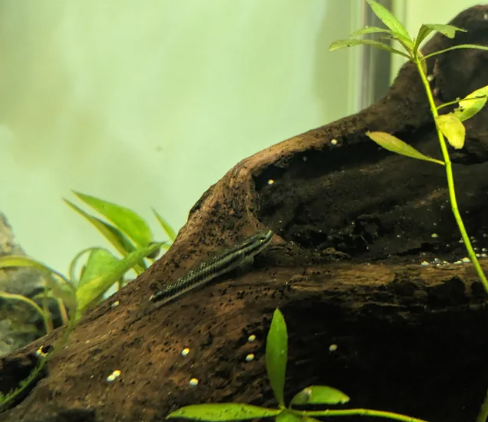
Seasoning is a patience-driven process that helps create a sustainable, stable, and supportive ecosystem in your aquarium. The benefits associated with seasoning are:
Stable Water Parameters
As the ecosystem created by seasoning is not as dependent on artificial factors as cycling, the water parameters, such as ammonia, nitrite, nitrate, and pH levels, stay much more stable during the lifetime of the tank.
Established Nitrogen Cycle
Again, the nitrogen cycle created by seasoning the tank is more robust and rarely relies on external factors like power cuts and water changes. The established nitrogen cycle usually starts with fish waste and ends with plants absorbing the nitrates.
Healthy Fish and Invertebrates
Stable water parameters, protection against disease pathogens, and reduced stress contribute to the overall health of fish and invertebrates inhabiting your aquarium. However, always stay vigilant towards introducing new members and using fertilizers.
Reduced Maintenance
Nitrate buildup and algae bloom are drastically reduced in matured tanks. Therefore, water changes, filtration system maintenance, and vacuuming requirements are drastically reduced in seasoned tanks. However, you may need to occasionally trim the plants and clean the glass for decorative purposes.
Enhanced Biodiversity
Seasoned tanks are much more biodiverse in nature and have the necessary ecology to contain outbreaks. Cycled tanks, on the contrary, rely on the immunity of the inhabitants.
Also Read: Under Gravel Filter – What Is It & How Does It Work?
Drawbacks of Seasoning
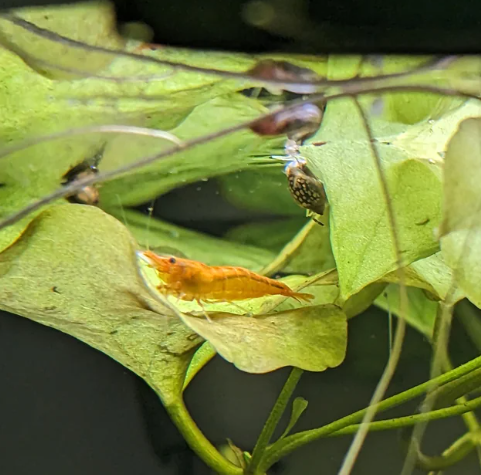
The drawbacks of a seasoned tank are as follows,
Limited Aquascaping Possibilities
Aquascaping can be disruptive to the existing ecosystem and may even crash the whole process. While little re-arrangements may not be as fatal, major changes shouldn’t be tried without proper precautions.
Accumulation of Detritus
Over time, dead leaves, uneaten food, and organic debris can accumulate in the substrate and other areas of the tank. While the bacteria colonies are likely to break them down, excessive buildups can cause issues.
Overgrown Plants
A surplus of nutrients in the seasoned tank can help the plants outgrow the tank and cause issues for other inhabitants. Manual intervention is often required to trim them down.
Gradual pH Drift
Some seasoned tanks, over an extended period, may experience gradual changes in pH due to substrate breakdown or water hardness changes. Monitoring and addressing such issues are critical to sustain the ecosystem.
Substrate Compaction
Fine-grained substrates like deep sand or mud can compact over time and hinder water circulation. It may also restrict the growth of beneficial bacteria and create pockets of hydrogen sulfide gas.
Tips for Aquarium Seasoning
- Keep patience. Restrict the urge to introduce a large number of fish to the tank right away.
- Don’t evade manual intervention when it comes to overgrown plants and accumulated debris.
- Occasional substrate disturbance can help the bacteria colonies stay healthy.
- Don’t overstock or overplant the aquarium.
- Don’t introduce new fish or plants right away. Keep them quarantined for a few days to avoid the introduction of new pathogens.
- Don’t overfeed your fish to avoid excessive nutrient buildup.
- Don’t use fertilizers unless absolutely necessary. Fertilizers can disrupt pH balance and water hardness.
Also Read: Filter Flow Rate Guide – DPH Definition & Turnover Rate
FAQs
Yes, aquarium cycling is necessary to break down the harmful toxins in the tank. Harmful substances, such as ammonia and nitrite, are broken down into less harmful nitrates to reduce stress and promote the well-being of your fish.
You should at least cycle your tank with liquid ammonia dosing for a few weeks before you can see a spike in nitrate levels. At this point, you may perform a water change and add fish to the tank. Plants, however, may be placed before and during the cycling.
Elevated nitrate levels, reduced ammonia levels, and a stable pH are the signs of a cycled/seasoned tank. The excessive nitrates are either removed by water changes or absorbed by the plants.
The Bottom Line
There isn’t a set answer to which one is better between cycling and seasoning your aquarium. Cycling is the necessary approach that helps you start your new aquarium, while seasoning is an ongoing process that matures over time. Hopefully, you’ll be able to understand more about both the processes from this article and embrace the one best suited for you.

